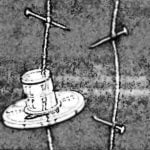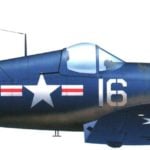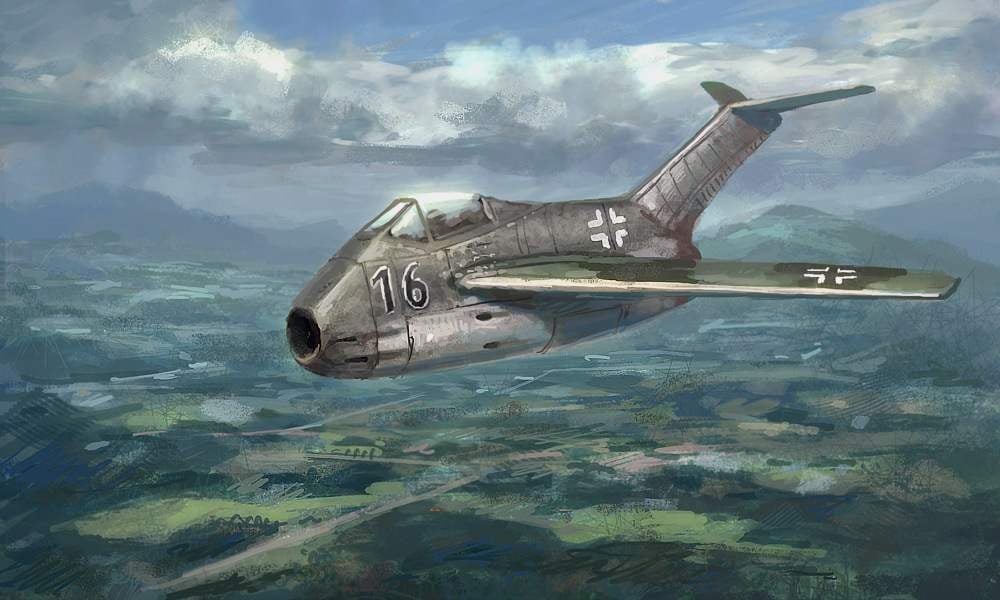 Recall. During the Second world war working on jet engines were in Germany on a broad front. They are ahead in this area all of the country and was able to convey in the production of two types of TRD – Ju-YuMO 004 and BMW 003. Equipped with their first jet aircraft – the Me 262, he 162 and ar 234 was the undoubted success of the German scientists and engineers. These aircraft are widely known, but the design idea was not on, and the command of the Luftwaffe in July 1944, announced a competition for the creation of the fighter that can replace the Me 262 and had the best flight and operational data.
Recall. During the Second world war working on jet engines were in Germany on a broad front. They are ahead in this area all of the country and was able to convey in the production of two types of TRD – Ju-YuMO 004 and BMW 003. Equipped with their first jet aircraft – the Me 262, he 162 and ar 234 was the undoubted success of the German scientists and engineers. These aircraft are widely known, but the design idea was not on, and the command of the Luftwaffe in July 1944, announced a competition for the creation of the fighter that can replace the Me 262 and had the best flight and operational data.
Requirements for a new fighter was set out in the Technical requirements of the RLM 226/II, dated 15 July 1944 They stipulated that the new fighter will be single-engine and have a new turbojet Heinkel HeS 001 Hirt, with an estimated thrust of 12.75 kN (1300 kgs). The work was conducted already in 1939, and the Germans hoped that they will be able to arrange its production. These hopes were not justified – until the end of the war was built only a few prototypes. The rejection of the twin-engined fighter in favor of the concept of”One engine – one plane” at the time, had serious arguments. The fact that the production of engines was small, and their lifetime is much less than that of the piston, not allowing them to build a lot of twin-engine fighters. On the other hand, to create a single-engine plane was not very simple – not enough thrust from the jet engines, requiring maximum ease of the glider.
Other paragraphs of the requirements was that the maximum speed should be 1000 km/h at 7000 m, fuel capacity – 1000 liters (30 min flight), and a service ceiling of 14 000 m. equipment expected from the 4 cannons MK 108 caliber 30 mm. the Pilot must be in a pressurized cabin with front and back protection from bullets caliber 12.7 mm. the Latter requirement stemmed from the experience of the struggle against American bombers b-17, the arrow which side had the guns. In General, the fight against heavy bombers of the allies was the main task of the new fighter. Not filmed the task of maneuvering air combat, so it was decided in the case of a single-engine plane. With regard to technological requirements, it was recommended strongly to reduce the use of scarce materials, and instead make greater use of steel and wood.
The competition in that hopeless situation in which Germany was at that time causes admiration. No less surprising is the fact that the competition was attended by all the major aviation firms. This is due to two factors: firstly, the German science and technology had great potential, and secondly – a business led initiative development of jet aircraft since the early 1940-ies. The winner of the contest became the company Focke-Wulf. Her project, which received the official designation TA 183 (named a rising design stars of the company – Kurt Tank) were recommended in production, but remained only on paper and was never built.
Aerodynamicist Hans Multhopp with model aircraft TA 183. Photo 1954
Fighter model TA 183 during a wind tunnel. This version has a wing with a positive angle transverse “V”, stabilizer – with a negative angle transverse “V”
TL-Jager -prototype Flitzer. The project fighter with mixed propulsion system
In fact, the firm Focke-Wulf began work on jet aircraft later their competitors. In March 1943 there was a project involving the placement of the nose is heavily modified fuselage of the Fw 190 with the TRD YuMO 004В. In this case, a plane being transferred to the scheme, reminiscent of the post-war the Yak-15. The project was rejected.
Then in may 1943, Kurt Tank proposed another variant where the engine was located under the newly designed fuselage. It also rejected – because of the danger to the pilot landing on the belly. Taking into account criticism, C. Tank joined both the project and has offered a fighter with the revolutionary for that time scheme.
The combined power-plant, consisting of turbojet and rocket engines, was located on the end of a short fuselage. The intakes were removed to the front edge of the wing. The air ducts turned out badly curved, but short. The combustion chamber of the rocket engine is the turbojet engine nozzle. The tail was double, and consisted of a straight stabilizer and two fins on the ends of the beams. In front of the short fuselage housed the armament, cockpit and niche nose landing gear. Main legs retracted into the wing. The wing had a moderate sweep of 27° and a small transverse V. In the process of further elaborations from rockets refused and left with only one turbojet. The result is a project known as Flitzer. He was brought to the stage of wooden mock-up, but build it did not. The plane had a wingspan of 8 m, a length of 10.55 m. empty Weight – 3200 kg, and take – 4750 kg. Armament consisted of two cannons MK 108 caliber 30 mm and two MS 151/20 caliber of 20 mm. Maximum speed was assumed to 875 km/h at ground level, the ceiling of 13,000 m and range – 660 km. the Concept of this machine was repeated by the British in the planes De Hevilend a Vampire, and then the sea vixen.
Others by the development of jet aircraft chosen by the designers of the Focke-Wulf was the application of the frontal air intake, fuselage mid-length with a short tail boom and T-tail. As expected, simultaneous replacement of the jet Me 262 and the Me 163 rocket, the first projects had a combined power plant. The rocket engine allows you to quickly gain altitude and speed, and propulsion turbojet engines to continue the flight and conduct maneuvering air combat. In the second half of 1944 the Luftwaffe leadership decided that the fighter should have one engine, which resulted in a recycling project, which was submitted to the contest.
The Luftwaffe and air Ministry felt that it best meets their requirements, and announced the project Focke-Wulf a winner. To commemorate the contributions of Kurt Tank, the design of this machine was given the designation TA 183. And fighter Messerschmitt R. 1101 official designation (IU 330) has not received, since the machine never was listed and was built semi-underground.
RLM has put forward four areas, which were to develop the project TA 183, which is reflected in the specifications, marked Ra.
Ra 1 (January 1945) suggested the development of concept aircraft with combination power plant. The stock of rocket fuel would increase due to the underwing external fuel tanks. They had to accommodate 350 l composition of T and 180 l of composition C. thus the total stock of rocket fuel was up to 950 l, which should be enough for 200 with a working rocket engine.
Ra 2 was a fallback in the absence of the HeS 011 engine. Then the first prototype of the TA 183 V1 was supposed to equip the engine YuMO 004В. Further delays in the release of the main engine on the same variant was supposed to build V2 and V3.
Ra 3 was planned to create as a high-altitude interceptor, with increased to 11 m wingspan.
Ra 4 was similar to Ra 3 but with the armor protection of critical parts.
TA 183 A-0 was supposed to be a single mid with swept wings. The fuselage had a metal structure, and the wings and tail mixed with wood and steel. Moreover, the use of steel, wood and aluminum were distributed (by weight) – 40%, 23% and 21%. In front of the short fuselage housed the frontal air intake and the duct. Above the duct was in the cockpit with a sliding canopy. And the niche front. In the middle part, on the sides, there was the weapon – four cannons MK 108 with ammo 80 rounds per gun. The number of guns could be reduced to two, in the case of external suspension. Immediately behind the cabin is the fuel tank. Other tanks were placed in the wing. Total fuel capacity was 1565 L. For the weapons bays were niches for cleaning the main landing gear. And finally, the rear part of the fuselage was occupied by the engine HeS 011А.
The aerodynamic configuration of the machine. The author of the aerodynamics Myldap. Striking long keel with a large sweep. The keel plays the role of the tail boom to stabilizer and ensure sufficient shoulder elevators. To ensure strength had to be applied to a thick keel profile. Swept the stabilizer is located on the top of the keel and has positive cross V. Wing span of 10 m had a sweep 40° to the front edge. It was made without restriction, without transverse V and carried the ailerons and flaps. Length – 8.9 m, empty weight – 2830 kg take – off weight of 4,300 kg Maximum speed at the ground -870 km/h at 7000 m – 955 km/h, a ceiling of 14,000 m.
![Simplified project of Kurt Tank]()
Simplified project of Kurt Tank
Realizing the unusual appearance of the selected fighter, especially in terms of plumage, and in anticipation of a possible rejection of him by some leaders of the RLM and the Luftwaffe, K. Tank decided to err, and in parallel developed the project of the fighter more than the usual kind. Plan “project V, Enfort III” was signalen, with a longer fuselage short tail boom. The cabin was moved to the middle part of the fuselage, and weapons, reduced to two MK 108, placed in the upper part of the nose compartment. The sweep angle was reduced to 35°. But the main thing – the tail has become a classic. According to calculations, the aircraft came out with better performance data than the TA 183.
The adjusted version, with a modified fuselage and shifted forward cabin, received the designation Focke-Wulf 252. After the recognition of the TA 183, the winner of the contest, other projects are frozen, and all forces were thrown on the pre-production TA 183.
RLM ordered the construction of 16 prototypes, two of which were to be used for the ran. This order was expected to perform in bad Elsene, in parallel preparing a production in Bremen and Detmold and its vicinity. February 23 was an order of serial TA 183 A-0, the first of which was to take off no later than September, 1945, Serial modernisation of the TA 183A-1 had reduced to two MK 108 armament. In addition, guns were displaced forward to 900 mm, and the vacated space used for extra fuel tanks. The first of the serial TA 183A-1 had to fly 25 Oct 1945, But these plans weren’t fated to come true – Germany surrendered before.
The article mentioned a guided missile X-4, which was supposed to equip some fighters. The result was a pretty picture: jet fighter with swept wings, armed with guided missiles. Sometimes on the nose or TA 183 R 1101 pririsovyvat “antler” radar. But all this – most likely, the legends that appeared after the war. To accommodate radars, these aircraft didn’t have the space. And external antennas at high speeds hopelessly spoiled the aerodynamics of a light aircraft. As for the guided missile X-4, then the design was crude and had a congenital defect that the Germans did not have time to address before the moment the laboratory is involved in X-4, was bombed. The fact that the missile was controlled by wire, as some samples of anti-tank missiles. But in the case of X-4 wire control has not crept along the ground and hung in the air. As a result, the alignment system “missile wire” shifted backwards. As a result, the rocket lost stability in the second half of the trajectory. It was discovered by the French who got the samples and components X-4, their they experienced after the war. I’m not talking about aggressive components of the fuel and the piston system in a rocket engine. The proximity Fuze was not there then.
After the war Kurt Tank moved to Argentina. At the time, she willingly accepted German immigrants, including war criminals. There he managed to gain the support of the government and using its expertise in the TA 183, and built the Pulqui II jet fighter, tested by another German major Otto Begrenzen. Aerodynamicist Hans Millchap moved to Britain, where he lived until his death in 1972
Thus ended this contest is conducted by the Nazi government in the extreme conditions of military defeats, bombing and incipient decay. And though tangible results seem insignificant, the ideas developed by German scientists and engineers at the time, became the Foundation for the development of aviation for many years after the war.
K. KUZNETSOV
Literature
1. Nowa Technika Wojskowa 2002.
2. Marek Murawski. Samoloty Luftwaffe. Lampart, Warszawa 1997.
3. Weslaw Baczkowski. Samoloty Odrzutowe 1939 – 1945. Iglica. 1998.
4. Janusz Ledwoch. Luftwaffe 1946. Wydawnictwo Militaria. Warszawa 1996.
Recommend to read
 WITHOUT PEGS
WITHOUT PEGS
Often at home you want to hang for drying items that cannot be secured with pin (for example, snails tiered photoback). Succeed with a string tied to nails or sticks out in any hole... F4U CORSAIR – TEN YEARS IN THE SERIES
F4U CORSAIR – TEN YEARS IN THE SERIES
Fighter F4U Corsair the Chance Vought company refers to those aircraft that forever left a mark in the history of world aviation. The involvement of these aircraft in the air battles...
 Recall. During the Second world war working on jet engines were in Germany on a broad front. They are ahead in this area all of the country and was able to convey in the production of two types of TRD – Ju-YuMO 004 and BMW 003. Equipped with their first jet aircraft – the Me 262, he 162 and ar 234 was the undoubted success of the German scientists and engineers. These aircraft are widely known, but the design idea was not on, and the command of the Luftwaffe in July 1944, announced a competition for the creation of the fighter that can replace the Me 262 and had the best flight and operational data.
Recall. During the Second world war working on jet engines were in Germany on a broad front. They are ahead in this area all of the country and was able to convey in the production of two types of TRD – Ju-YuMO 004 and BMW 003. Equipped with their first jet aircraft – the Me 262, he 162 and ar 234 was the undoubted success of the German scientists and engineers. These aircraft are widely known, but the design idea was not on, and the command of the Luftwaffe in July 1944, announced a competition for the creation of the fighter that can replace the Me 262 and had the best flight and operational data.






